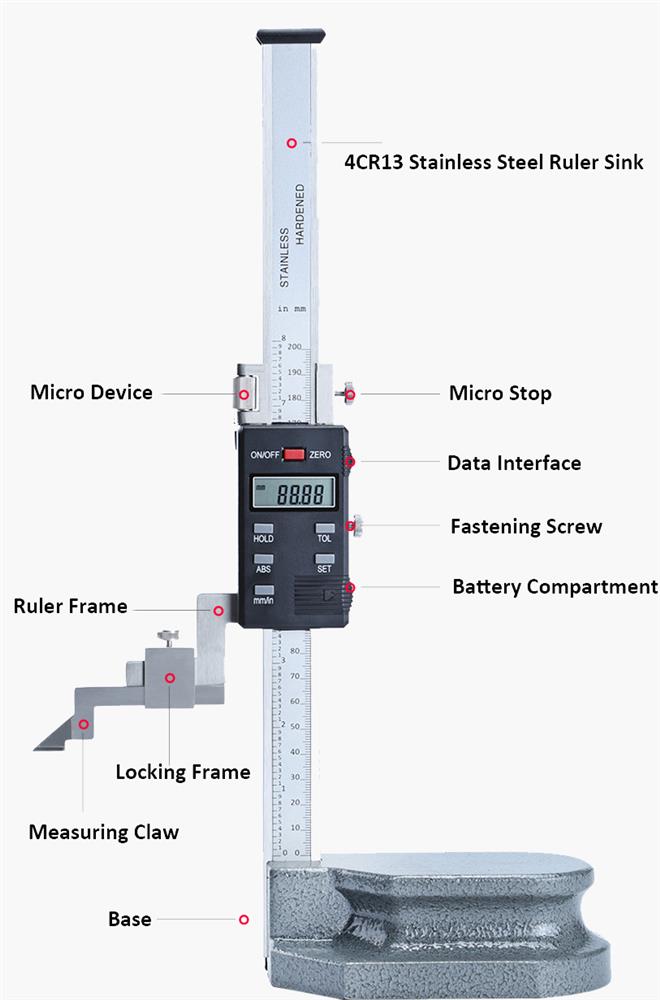Height gauges are also known as height vernier calipers. As the name suggests, its main purpose is to measure the height of workpieces, and it is also often used to measure shape and position tolerances, and sometimes to mark lines.
What is a digital height gauge?
A height gauge is a measuring device used for determining the height of objects, and for marking items to be worked on. These measuring tools are used in metalworking or metrology to either set or measure vertical distances; the pointer is sharpened to allow it to act as a scriber and assist in marking out work pieces.
Height gauges may also be used to measure the height of an object by using the underside of the scriber as the datum. The datum may be permanently fixed or the height gauge may have provision to adjust the scale, this is done by sliding the scale vertically along the body of the height gauge by turning a fine feed screw at the top of the gauge; then with the scriber set to the same level as the base, the scale can be matched to it. This adjustment allows different scribers or probes to be used, as well as adjusting for any errors in a damaged or resharpened probe.
What are the parts of a Height Gauge?
The following are the main parts of the digital height gauge:

- Base: The base is made to high proportions to ensure the rigidity and stability of the gauge. The underside of the base is relieved leaving a surface around the outside edge of at least 7mm width and an air gap is provided across the surface to connect the received part with the outside. It is lapped to an accuracy of 0.005mm as measured over the total span of the surface considered.
- Beam: To ensure rigidity during use, the cross-section is chosen. The rigidity should be such that an upward force of 1kg is applied at the tip of the scriber when the measuring jaw is in its highest position such that there is no change in the parallelism of the jaw with a base of more than 0.005mm / 10mm of projection of the working surface of the scriber.
- Measuring jaw and Scriber: The projection of the measuring jaw of the high-accuracy digital height gauge from the edge of the beam should be at least equal to the projection of the base from the beam. For any position of the slider, the upper and lower gauging surfaces of the measuring jaw should be flat and parallel to the base within 0.008 mm The projection of a scriber beyond the jaw should be at least 25mm. Height gauges may have an offset scriber and the scale on the beam so positioned that when the scriber is coplanar with the base, the vernier is at zero position.
- Graduations: All graduations on the scale and the vernier should be clearly engraved and the thickness of graduation both on the scale and vernier should be identical and should be in between 0.05mm and 0.1mm. The perpendicular distance between the graduations on scale and graduations on vernier should have a dull finish and the graduation lines blackened in. Even a magnifying lens is provided to facilitate taking readings.
- Slider: It should have a good sliding fit along the full working length of the bema. A proper fitting is included to give a precise adjustment of the slider and a suitable clamp is fitted so that the slider can be effectively clamped to the beam after the final adjustment has been made.
Advantages of the height gauge
- Wide range of functions for use in different situations: Although there are many different models of height gauges on the market, similarities lie in the basic functions which are to measure the heights of workpieces. What sets each height gauge apart is the additional functions and abilities beyond measuring heights that are tailored to specific applications. For example, height gauges can also be used to measure the flatness and squareness of workpiece parts.
- High levels of precision and specifications that reduce inspection: For a height gauge to be effective, it must have good precision and resolution. Especially in digital models that are pricier, high levels of precision (also known as repeatability) can be achieved to ensure that all workpieces are tested under the same if not highly similar conditions. Furthermore, the measuring force applied to the workpiece tested should also be constant to generate consistent readings. Having consistent measuring conditions will allow operators to spend less time checking for the presence of anomalies, leading to greater levels of efficiency.
- Electronic and wireless capabilities: With the advancements in technology, devices are constantly being fitted with electronic and wireless capabilities and the height gauge is no exception. These capabilities provide users with the ease of reading with clarity and precision. Some models of height gauges are also able to store data from readings and connect directly to the floor network, aiding in the record-keeping and statistical analysis process.

